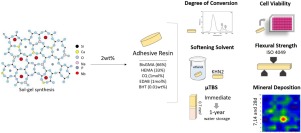当前位置:
X-MOL 学术
›
Dent. Mater.
›
论文详情
Our official English website, www.x-mol.net, welcomes your
feedback! (Note: you will need to create a separate account there.)
Niobium containing bioactive glasses as remineralizing filler for adhesive resins.
Dental Materials ( IF 4.6 ) Pub Date : 2019-11-30 , DOI: 10.1016/j.dental.2019.11.014 Gabriela de Souza Balbinot 1 , Fabrício Mezzomo Collares 1 , Tiago Luis Herpich 1 , Fernanda Visioli 2 , Susana Maria Werner Samuel 1 , Vicente Castelo Branco Leitune 1
Dental Materials ( IF 4.6 ) Pub Date : 2019-11-30 , DOI: 10.1016/j.dental.2019.11.014 Gabriela de Souza Balbinot 1 , Fabrício Mezzomo Collares 1 , Tiago Luis Herpich 1 , Fernanda Visioli 2 , Susana Maria Werner Samuel 1 , Vicente Castelo Branco Leitune 1
Affiliation

|
OBJECTIVE
The aim of this study was to incorporate sol-gel-derived bioactive glass as filler into experimental adhesive resins and evaluate the influence of glass composition on the physicochemical and biological properties of the developed adhesives.
MATERIALS AND METHODS
Sol-gel particles were produced with or without the addition of niobium (BAGNb or BAG, respectively). The produced particles were incorporated (2wt%) into experimental adhesive resins formulated with 66wt% bisphenol A-glycidyl methacrylate and 33wt% hydroxyethyl methacrylate. Ethyl dimethyl-4-aminobenzoate and camphorquinone were used as photoinitiator system. Two experimental groups were produced: ABAGNb and ABAG. The adhesive without particles was used as control (ACG). The materials were tested for their degree of conversion, softening in solvent, and cytotoxicity. The mineral deposition was analyzed by Raman spectroscopy. Flexural strength and immediate and 1-year microtensile bond strength were evaluated.
RESULTS
No statistical difference was found in degree of conversion. ABAGNb showed reduced softening and higher mineral deposition than ACG and ABAG after 28 days. ABAG and ABAGNb resulted in higher cell viability and lower flexural strength when compared to ACG. After 1-year, ABAGNb and ABAG presented statistically significant lower μTBS values.
SIGNIFICANCE
Sol-gel-derived bioactive glasses promoted increased mineral deposition and cell viability for experimental adhesives with increased phosphate content and longitudinal μTBS values for the ABAGNb group. These results suggest the potential of the studied particles to be applied as bioactive fillers for dental adhesives. Reductions in longitudinal μTBS and flexural strength, however, were observed for both glasses compositions and must be considered.
中文翻译:

含铌的生物活性玻璃作为粘合剂树脂的再矿化填料。
目的本研究的目的是将溶胶-凝胶衍生的生物活性玻璃作为填料掺入实验性粘合剂树脂中,并评估玻璃成分对已开发粘合剂的物理化学和生物学特性的影响。材料与方法溶胶-凝胶颗粒是在添加或不添加铌(分别为BAGNb或BAG)的情况下生产的。将产生的颗粒掺入(2重量%)到由66重量%的双酚A-甲基丙烯酸缩水甘油酯和33重量%的甲基丙烯酸羟乙酯配制的实验粘合剂树脂中。将4-氨基苯甲酸二甲基乙酯和樟脑醌用作光引发剂体系。产生了两个实验组:ABAGNb和ABAG。没有颗粒的粘合剂用作对照(ACG)。测试了这些材料的转化度,在溶剂中的软化和细胞毒性。矿物沉积物通过拉曼光谱分析。评估抗弯强度以及即时和1年微拉伸粘合强度。结果转化率没有统计学差异。与ACG和ABAG相比,ABAGNb在28天后显示出降低的软化和更高的矿物质沉积。与ACG相比,ABAG和ABAGNb导致更高的细胞活力和更低的抗弯强度。一年后,ABAGNb和ABAG呈现出统计学上显着较低的μTBS值。意义溶胶凝胶衍生的生物活性玻璃促进了实验性粘合剂的矿物质沉积和细胞活力的增加,而ABAGNb组的磷酸盐含量和纵向μTBS值均增加了。这些结果表明,所研究的颗粒有可能用作牙科粘合剂的生物活性填料。
更新日期:2019-11-30
中文翻译:

含铌的生物活性玻璃作为粘合剂树脂的再矿化填料。
目的本研究的目的是将溶胶-凝胶衍生的生物活性玻璃作为填料掺入实验性粘合剂树脂中,并评估玻璃成分对已开发粘合剂的物理化学和生物学特性的影响。材料与方法溶胶-凝胶颗粒是在添加或不添加铌(分别为BAGNb或BAG)的情况下生产的。将产生的颗粒掺入(2重量%)到由66重量%的双酚A-甲基丙烯酸缩水甘油酯和33重量%的甲基丙烯酸羟乙酯配制的实验粘合剂树脂中。将4-氨基苯甲酸二甲基乙酯和樟脑醌用作光引发剂体系。产生了两个实验组:ABAGNb和ABAG。没有颗粒的粘合剂用作对照(ACG)。测试了这些材料的转化度,在溶剂中的软化和细胞毒性。矿物沉积物通过拉曼光谱分析。评估抗弯强度以及即时和1年微拉伸粘合强度。结果转化率没有统计学差异。与ACG和ABAG相比,ABAGNb在28天后显示出降低的软化和更高的矿物质沉积。与ACG相比,ABAG和ABAGNb导致更高的细胞活力和更低的抗弯强度。一年后,ABAGNb和ABAG呈现出统计学上显着较低的μTBS值。意义溶胶凝胶衍生的生物活性玻璃促进了实验性粘合剂的矿物质沉积和细胞活力的增加,而ABAGNb组的磷酸盐含量和纵向μTBS值均增加了。这些结果表明,所研究的颗粒有可能用作牙科粘合剂的生物活性填料。











































 京公网安备 11010802027423号
京公网安备 11010802027423号